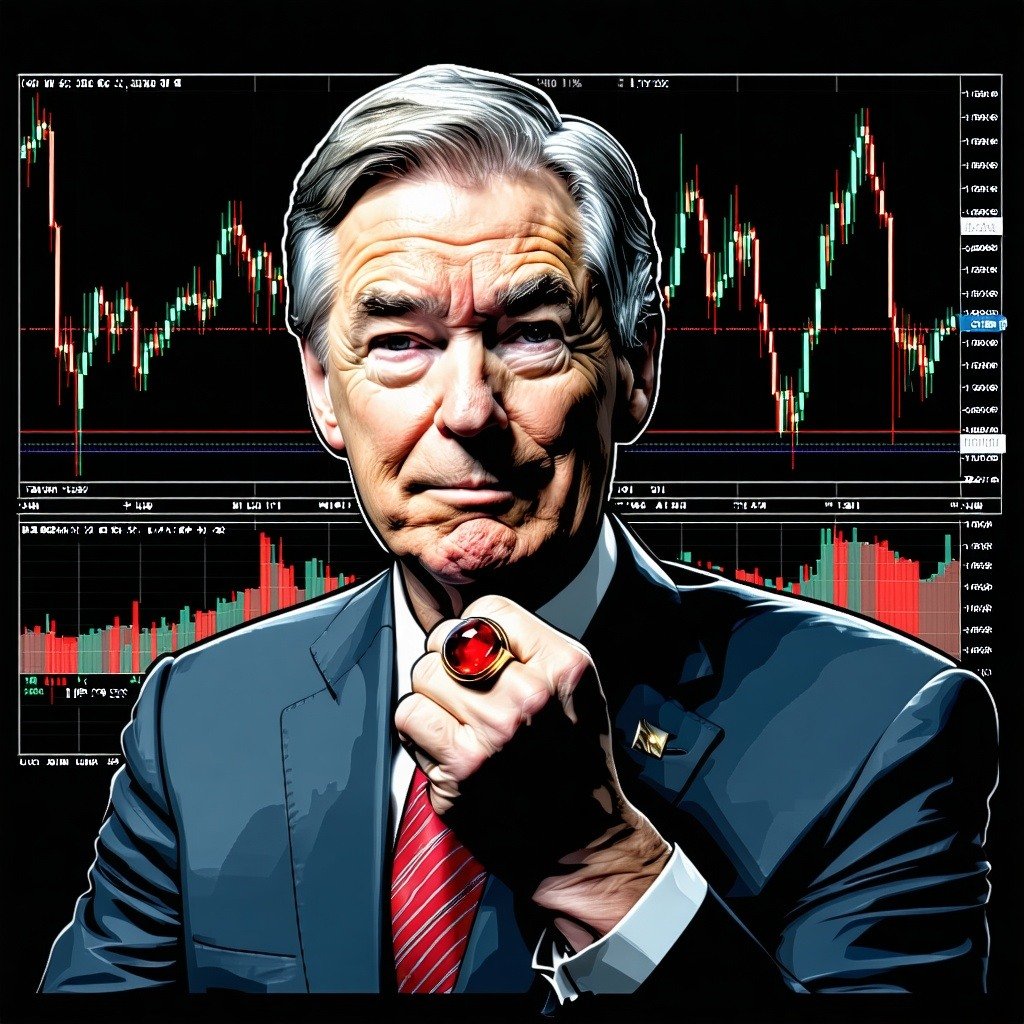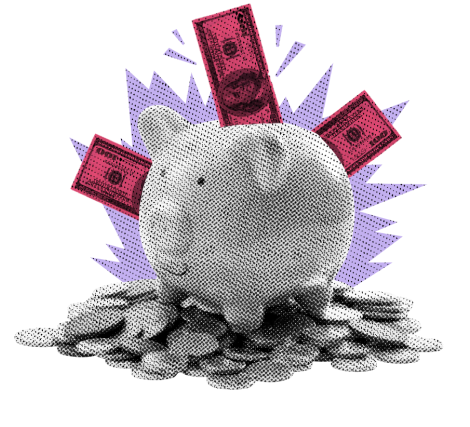
Powell’s “no, exclamation mark” should be your wake-up call.
KEY TAKEAWAYS
- U.S. trade policy is poorly executed and exacerbating market pain
- The Fed is boxed in by a dual mandate it can’t easily balance under current conditions
- The Fed Put is officially dead—Powell made that crystal clear
- The market is pricing in dysfunction, not just risk
- Investor mood is dark, and it’s not changing anytime soon without policy clarity
MY HOT TAKES
- Mood rings lied—markets don’t
- Powell just buried the Fed Put—with an exclamation mark
- Yesterday’s trading session? Black mood ring, red market
- Chips down, tariffs up, and Powell’s still on hold
- Tired. Nervous. Unsure. That’s the mood—confirmed by price action
- You can quote me: “Yesterday’s session was a perfect example of every form of creature hiding under investors’ beds these days.”
Moody ring. I think that it was sometime in the 1970s, that some of my cooler, fashion-forward friends started to show up to school wearing gaudy rings that they claimed reflected their mood. Do you remember these mood rings? I can recall standing outside at recess (yeah, it was still a thing back then) staring at the rings with a gaggle of friends, waiting for it to turn color. Soon, almost every student in the class had one. I didn’t even try to convince my scientist father that I needed a ring that would reflect my mood–the hypothesis that it could accurately do so would be rejected within the first minute of my pitch.
Those rings were certainly crowd pleasers for a minute, and I am pretty sure, that while they did, indeed, change colors, that they were not an accurate barometer of one’s mood. The stock market, however–that IS a very accurate measure of investor sentiment. Do you want to gander a guess as to what that mood is right now? That was just a rhetorical question, you don’t have to answer it.
A few weeks back in an interview with the BBC World Service, the host asked me to describe US investors in one word, and I came up with three: tired, nervous, and unsure. His clever response was “why pick one when you can pick three!” Well, here we are a few weeks on from that interview, and I have to say, that description has certainly not changed. In fact, I would say that it has intensified, and yesterday’s session was a perfect example of every form of creature hiding under investors’ beds these days.
The day started off with a typical negative vibe caused by continuous ambiguity around the Administration’s trade policy. China had agreed to sit down with the US if the President could be respectful. I am not going to go there, other than to say, “President Xi, maybe focus on what is at stake and save the respect for the signing ceremony.” That aside, the fact that China was willing to talk should have been a positive development, but it was overshadowed by a disclosure filed by NVIDIA that a recent restriction on chip sales to China would cost the company some $5.5 billion this year. Beleaguered chip manufacturer, distant-cousin, AMD also made a similar revelation. Now, if you know the semiconductor industry, you know that everything remotely related to those companies was going to have a difficult day.
And that would be that, another day of wealth and value destruction in what is the most promising economic development since the invention of the internet, and years earlier the PC… and may as well throw in the smartphone. All this, due to ill-thought-out economic policy. Noble goals, but really poor execution. Ok, the market, even though it has grown to expect developments like that, didn’t take kindly to the news.
There was hope of a turnaround, however. An off ramp from the highway of pain. That’s right, the good old Federal Reserve, and the Bank Boss was due to speak yesterday afternoon at the Economic Club of Chicago. Powell delivered a quick, pre-released speech which pretty-much toed the recent Fed line of inflation is not dead, there is uncertainty, we will keep fighting inflation. I thought that had been made pretty clear by the numerous appearances of FOMC members in these past few weeks. The Fed is on hold, if you weren’t listening.
The real action yesterday was not in the speech itself, but in the Q&A that followed. This is what we learned. Powell acknowledged that the tariffs and the looming trade war were inflationary. He also noted that all this could lead to not only inflation, but also economic slowdown and possibly increased unemployment. Are you seeing where this is going? The Fed has a dual mandate: keep prices stable, and maintain low unemployment, and both of those could go in the wrong direction, according to the Chairman. You know economists will never fully commit to anything 100%, and Powell stayed true to his craft. By using the word “could,” the Fed can maintain its wait and see policy. This should be no surprise. The Fed, just like the rest of us, has no idea where President Trump’s trade policy will end up. The result will not be good, but what is still unknown is just how not good… er, bad it will be.
You see, the Fed must always attempt to strike that balance between both of its mandates, and it has separate tools to fight each one, but it completely lacks one that treats both maladies. That is the conundrum the Fed is facing. Lowering rates too fast ahead of what promises to be an inflationary trade regime can intensify inflation. Not lowering rates can cause unemployment to rise. The Chair also acknowledged that this passage of unknowns could lead to declines in consumption and investment. That is code for unemployment, and the prescription for that is rate cuts.
And rate hikes? Well, Powell did not address that scenario, but suffice it to say, that rate-hiking cannot fix inflation related to the inevitable supply chain problems that are likely coming our way if this impasse persists.
And finally, it would not be a Fed discussion without the famous Fed Put. The Fed Put is the hope that the Fed would step in to prop up falling stock prices. Let’s be really clear, the Fed’s dual mandate does not include helping the stock market. When asked if the Fed would act to bolster the markets, he answered “no, exclamation mark.” That is a hard “no,” and should be completely expected.
No acting Fed Chair would ever pledge their allegiance to the banal stock market. No. The Fed is only responsible for the economy, and the market will do what it will to reflect the estimates, or mood of investors. Here is a little secret, the Fed DOES watch the stock market. In fact, recent declines in stocks and bonds are a natural form of monetary tightening, so if the Fed is worried about inflation, markets are helping the cause. However, if markets decline to the point of causing consumption to slip, that is a different story. A decline in consumption would lead to unemployment and that IS a Fed mandate, so indeed the Fed may ultimately have to act.
Based on Jerome Powell’s appearance yesterday, the Fed is in no hurry to make any concessions to markets. That message to investors was clear. There was also a message to the President which was something like “the Fed is going to do nothing until you are clear with policy,” and that is not likely to be forthcoming any time soon. In response to the Chair’s unsurprising admissions, stocks tumbled, doubling down on the earlier session pain.
Yesterday’s price action clearly reflects the mood of investors right now. Tired, nervous, and unsure. I think the Mood Ring color for that is black, though red would be more accurate these days. The mood ring fad disappeared almost as quickly as it started, and I was happy to focus my efforts on getting a CB Radio or the hit sensation video game Pong. Pet rocks were not my thing.
YESTERDAY’S MARKETS
Stocks clamored for air yesterday and none was forthcoming with indexes closing deeply in the red. Trade-restricted NVIDIA announced revenue impairments pressuring tech stocks and the broader markets. Fed Chair Powell’s unwillingness to say anything at all dovish at a Q&A caused losses to accelerate, though stocks closed off their lows. A Retail Sales figure showed healthy growth, though many expect those to be short-lived with upcoming, tariff-related price hikes.

NEXT UP
- Housing Starts (March) are expected to have declined by -5.4% after jumping by 11.2% in the prior month.
- Building Permits (March) may have slipped by -0.6% after February’s decline of -1.0%.
- Initial Jobless Claims (April 12th) is expected to come in at 225k, slightly higher than last week’s 223k claims.
- Fed Governor Michael Barr will speak today.
- Markets are closed tomorrow for Good Friday. Next week, earnings intensify, and we will get the Leading Economic Index, more regional Fed reports, more housing numbers, flash PMIs, Beige Book, and Durable Goods Orders. Check back in on Monday to get your economics and earnings calendars so you can get ahead of and destroy your competition.
- Today’s important earnings: UnitedHealth Group, Truist, DRHorton, KeyCorp, Blackstone, American Express, State Street, and Netflix.
.png)

